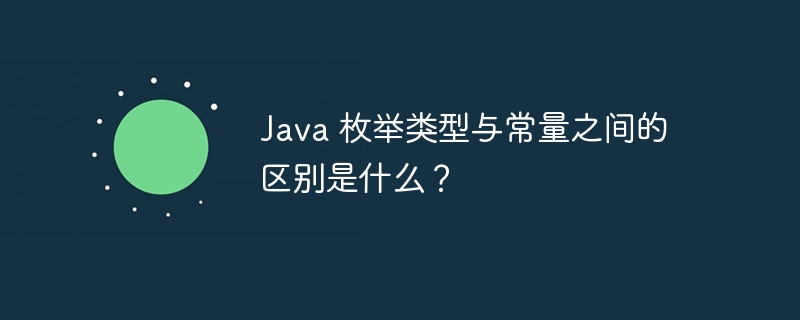What is the difference between Java enumeration types and constants?
Both enumeration types and constants in Java represent fixed values, but enumeration types are type-safe objects with methods and properties, while constants are unchangeable variables, not objects, and have more type flexibility.

The difference between Java enumeration types and constants
In Java, enumeration types and constants are used Represents a fixed value, but there are some key differences between them:
Enumeration type
- An enumeration type is a set of constants with a name and value .
- Enumeration values are objects whose methods and properties can be accessed using the
.operator. - Enumeration types are type-safe, which means that enumeration values can only be assigned to variables of that type.
Constant
- Constant is an unchangeable variable whose value is determined at compile time.
- Constants are not objects and therefore cannot access methods or properties.
- Constant values can be of any type, including primitive types, String and custom classes.
Practical case:
Use enumeration types to represent days of the week:
enum DayOfWeek {
MONDAY, TUESDAY, WEDNESDAY, THURSDAY, FRIDAY, SATURDAY, SUNDAY
}
DayOfWeek day = DayOfWeek.MONDAY;
System.out.println(day.name()); // MONDAYUse constants to represent the maximum file size:
final int MAX_FILE_SIZE = 1024 * 1024 * 10; // 10MB
if (file.size() > MAX_FILE_SIZE) {
// 文件太大
}Key differences:
| Features | Enumeration types | Constant |
|---|---|---|
| Type safety | Yes | No |
| Object | Yes | No |
| Method and property access | Yes | No |
| Yes Transgender | Unchangeable | Unchangeable |
##Conclusion:
As needed Features Selecting enumeration types or constants is critical to writing clear, maintainable Java code. Enumeration types provide greater type safety and extensibility, while constants are more flexible and simpler.The above is the detailed content of What is the difference between Java enumeration types and constants?. For more information, please follow other related articles on the PHP Chinese website!

Hot AI Tools

Undress AI Tool
Undress images for free

Undresser.AI Undress
AI-powered app for creating realistic nude photos

AI Clothes Remover
Online AI tool for removing clothes from photos.

Clothoff.io
AI clothes remover

Video Face Swap
Swap faces in any video effortlessly with our completely free AI face swap tool!

Hot Article

Hot Tools

Notepad++7.3.1
Easy-to-use and free code editor

SublimeText3 Chinese version
Chinese version, very easy to use

Zend Studio 13.0.1
Powerful PHP integrated development environment

Dreamweaver CS6
Visual web development tools

SublimeText3 Mac version
God-level code editing software (SublimeText3)
 Excel find and replace not working
Aug 13, 2025 pm 04:49 PM
Excel find and replace not working
Aug 13, 2025 pm 04:49 PM
Checksearchsettingslike"Matchentirecellcontents"and"Matchcase"byexpandingOptionsinFindandReplace,ensuring"Lookin"issettoValuesand"Within"tocorrectscope;2.Lookforhiddencharactersorformattingbycopyingtextdirectly
 How to deploy a Java application
Aug 17, 2025 am 12:56 AM
How to deploy a Java application
Aug 17, 2025 am 12:56 AM
PrepareyourapplicationbyusingMavenorGradletobuildaJARorWARfile,externalizingconfiguration.2.Chooseadeploymentenvironment:runonbaremetal/VMwithjava-jarandsystemd,deployWARonTomcat,containerizewithDocker,orusecloudplatformslikeHeroku.3.Optionally,setup
 How to configure logging in a Java application?
Aug 15, 2025 am 11:50 AM
How to configure logging in a Java application?
Aug 15, 2025 am 11:50 AM
Using SLF4J combined with Logback or Log4j2 is the recommended way to configure logs in Java applications. It introduces API and implementation libraries by adding corresponding Maven dependencies; 2. Get the logger through the LoggerFactory of SLF4J in the code, and write decoupled and efficient log code using parameterized logging methods; 3. Define log output format, level, target (console, file) and package level log control through logback.xml or log4j2.xml configuration files; 4. Optionally enable the configuration file scanning function to achieve dynamic adjustment of log level, and SpringBoot can also be managed through Actuator endpoints; 5. Follow best practices, including
 XML Data Binding with Castor in Java
Aug 15, 2025 am 03:43 AM
XML Data Binding with Castor in Java
Aug 15, 2025 am 03:43 AM
CastorenablesXML-to-Javaobjectmappingviadefaultconventionsorexplicitmappingfiles;1)DefineJavaclasseswithgetters/setters;2)UseUnmarshallertoconvertXMLtoobjects;3)UseMarshallertoserializeobjectsbacktoXML;4)Forcomplexcases,configurefieldmappingsinmappin
 js add element to start of array
Aug 14, 2025 am 11:51 AM
js add element to start of array
Aug 14, 2025 am 11:51 AM
In JavaScript, the most common method to add elements to the beginning of an array is to use the unshift() method; 1. Using unshift() will directly modify the original array, you can add one or more elements to return the new length of the added array; 2. If you do not want to modify the original array, it is recommended to use the extension operator (such as [newElement,...arr]) to create a new array; 3. You can also use the concat() method to combine the new element array with the original number, return the new array without changing the original array; in summary, use unshift() when modifying the original array, and recommend the extension operator when keeping the original array unchanged.
 Performance Comparison: Java vs. Go for Backend Services
Aug 14, 2025 pm 03:32 PM
Performance Comparison: Java vs. Go for Backend Services
Aug 14, 2025 pm 03:32 PM
Gotypicallyoffersbetterruntimeperformancewithhigherthroughputandlowerlatency,especiallyforI/O-heavyservices,duetoitslightweightgoroutinesandefficientscheduler,whileJava,thoughslowertostart,canmatchGoinCPU-boundtasksafterJIToptimization.2.Gouseslessme
 How to work with JSON in Java
Aug 14, 2025 pm 03:40 PM
How to work with JSON in Java
Aug 14, 2025 pm 03:40 PM
ToworkwithJSONinJava,useathird-partylibrarylikeJackson,Gson,orJSON-B,asJavalacksbuilt-insupport;2.Fordeserialization,mapJSONtoJavaobjectsusingObjectMapperinJacksonorGson.fromJson;3.Forserialization,convertJavaobjectstoJSONstringsviawriteValueAsString
 What is the assert keyword in Java?
Aug 17, 2025 am 12:52 AM
What is the assert keyword in Java?
Aug 17, 2025 am 12:52 AM
TheassertkeywordinJavaisusedtovalidateassumptionsduringdevelopment,throwinganAssertionErroriftheconditionisfalse.2.Ithastwoforms:assertcondition;andassertcondition:message;withthelatterprovidingacustomerrormessage.3.Assertionsaredisabledbydefaultandm







